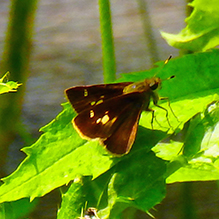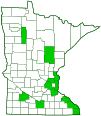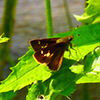little glassywing
(Vernia verna)
Conservation • Description • Habitat • Ecology • Distribution • Taxonomy
|
|
||||||||||||||
Description |
Little glassywing is a medium-sized grass skipper with a wingspan of 1 1 ⁄16″ to 1½″. The upperside of the both wings is dark brownish-black. The forewing has a cluster of four spots near the center and a row of three smaller spots near the margin. The central cluster consists of one large semi-transparent spot with two smaller pale spots above it and one smaller pale spot below it. The large spot is rectangular on the male, square on the female. The semi-transparent spot is what gives this species its common name. The underside of both wings is dark brown. The underside of the hindwing has a central band of very pale spots. The antennae are short and barred. Each antenna has a black swelling (club) at the tip; a white band just below the club; and a pale, thin, hooked extension (apiculus) at the end of the club. The caterpillar is green with a black head. The thorax and abdomen are moderately covered with short brown hairs, each with a brown bulbous base. Mature caterpillars are seen in early spring. |
Size |
Wingspan: 1 1 ⁄16″ to 1½″ |
Similar Species |
Northern broken-dash, Dun skipper, and little glassywing are called “the three witches” because their dark wings make it difficult to tell “which one is which.” Dun skipper (Euphyes vestris) male has no pale spots on the forewing and no row of faint spots on the hindwing below. The female has only two pale spots on the forewing. Northern broken-dash (Polites egeremet) has an orangish area on the leading edge of the forewing. The rectangular spot is smaller, orange or yellow, and not as square. |
Habitat |
Moist woodland openings and edges, moist brushy fields near woodlands, wetland edges, roadsides. Always near trees. |
Ecology |
Season |
One brood: mid June to early August |
Behavior |
Little glassywings often fly together with Dun skipper and northern broken-dash. Like all skippers, they have a rapid, darting flight. |
Life Cycle |
Males perch on low vegetation after noon waiting for passing females. The female lays pale greenish to white eggs in the afternoon on the leaves of purpletop tridens. Caterpillars make a shelter by rolling one leaf or tying adjacent leaves together with silk. They live in their shelters, exiting only at night to feed. They overwinter in their shelters as partially grown larvae and pupate in their shelters in the spring. |
Larva Hosts |
Leaves of purpletop tridens (Tridens flavus var. flavus) |
Adult Food |
Flower nectar of white, pink, and purple flowers, especially dogbane and milkweed. When those are not available, also nectar from yellow flowers. |
Distribution |
||
|
Sources 7, 21, 24, 29, 30, 75, 82, 83. Biodiversity occurrence data published by: Minnesota Biodiversity Atlas (accessed through the Minnesota Biodiversity Atlas Portal, bellatlas.umn.edu, 7/6/2025). |
|
| 7/6/2025 | ||
Occurrence |
||
|
||
Taxonomy |
|
Order |
|
Superfamily |
Papilionoidea (Butterflies) |
Family |
Hesperiidae (Skippers) |
Subfamily |
Hesperiinae (Grass Skippers) |
Tribe |
Hesperiini |
Suntribe |
Hesperiina (Branded Grass Skippers) |
Genus |
Vernia |
Subordinate Taxa |
|
|
|
Superfamily Genus |
|
Synonyms |
|
Hesperia vetulina Pamphila pottawattomie Pamphila sigida Polites sequoyah Pompeius verna Telesto sigida |
|
Common Names |
|
little glassywing |
|
Glossary
Apiculus
A thin hooked or pointed extension at the ends of each antenna just beyond the club of all skippers except skipperlings (subfamily Heteropterinae).
Visitor Photos |
||
Share your photo of this insect. |
||
This button not working for you? |
||
John Shier |
 |
This photo was taken today, along the bike trail about 1 mile east of the Schaar's Bluff trailhead in Dakota County Parks. |
MinnesotaSeasons.com Photos |
||
|
||
|
||

Slideshows |
|

Visitor Videos |
||
Share your video of this insect. |
||
This button not working for you? |
||
|
Other Videos |
||
Little Glassywing |
About
Published on Jul 1, 2014 Filmed and edited in Morris County, New Jersey Tamron SP 180mm Macro Lens All footage and music is exclusive property of Dave Blinder. |
The Witches |
About
Uploaded on Apr 18, 2011 Dun Skipper, Little Glassywing, Northern Broken-Dash, Crossline Skipper, and Tawny-edged Skipper |

Visitor Sightings |
||
Report a sighting of this insect. |
||
This button not working for you? |
||
Little Glassy Wing Butterfly |
Location: St. Francis, Anoka County |
MinnesotaSeasons.com Sightings |
||

Created: 7/5/2015 Last Updated: © MinnesotaSeasons.com. All rights reserved. |

